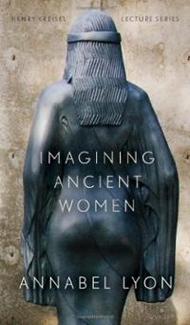Reviews
Nonfiction Review by Linda Rogers
Annabel Lyon, Imagining Ancient Women (Edmonton: University of Alberta and Canadian Literature Centre, 2012). Henry Kriesel Lecture Series, Paperbound, 68 pp., $10.95.
We can access the interior lives of children by giving them dollhouses with rooms dissected like bombed-out buildings. That is when we can see and hear the ticking of clockwork brains, time framed in musical notation, and the voices of storytellers. Would that we had documentation of the imaginings and reasoning of all the great thinkers and creators, minds like those of Homer, Parmigianino, and Bach, to examine. Speculation is the realm of scholarship, beginning with those rabbis who parsed the Pentateuch. Annabel Lyon has spared scholars some of the trouble with this public lecture, which gives first-person insight into the golden aura of fiction, the place where reality is transformed and enhanced by visceral imagination. Lyon, a relatively new star in the literary firmament, has actively gathered fairy dust, preparing herself with classical scholarship and study of the impeccable intonation of writing’s lyrical sister, music. Her obsession with antiquity and philosophers who risked their mortality when they articulated controversial belief systems led her to the very special relationship between a prince, Alexander, and a philosopher, Aristotle. Then as now, the programming of a child’s ethical thinking, what we call teaching, can change history.
In her first novel, The Golden Mean, Lyon captured a significant mentoring relationship, one that was not even trusted to Alexander’s banished mother, while challenging the belief that women cannot master male voices. Male and female voices transcended, Imagining Ancient Women, argues the parallel functions of history, the big story, and personal narratives. It is all, she argues, a dialectic process that leads to a greater compassion. Whether or not the big pictures succeed is debatable, but Lyon has concerned herself with the microcosm, the individual stories that focus human history, in this case the god in us, according to Aristotle, the father of humanism.
The logic that we are the many in the one requires a matrix and Lyon maintains that this matrix is our common humanity. The artist’s function in society is to represent social coherence in acts of grace. This is the lesson passed from Aristotle to Alexander, the warrior prince, and from Lyon to her readers. Redemption is the rapture. Lyon is not naive enough to believe that in life and/or in art the outcome is always a victory ride around our singular source of light, but it is always possible. Compassion is symmetry, the return to the first thing we know, which is love. Her lecture outlines the pitfalls of historical fiction; the distancing that is effected by the dry recollection of facts and details, the tempting capitulation to formula: “...so it’s my job as a writer to show the richness in the mundane,” she writes. For Aristotle, the Golden Mean was revealed in the natural world. This is the mantra of the great thinkers and artists of the Reformation and the later Romantic period when fiction really found its legs in the popular culture. Audiences, whether for opera, ballet, literature, drama, or visual art, needed to feel stories, which were at the same time particular and universal. If they were to enter the river of one, they needed to comprehend the balanced (truth/beauty) journey of a drop of water, Shelley’s “beaded bubbles.” In The Golden Mean, Lyon told the story of men in a man’s world. Her lecture outlines the examples that inspired her, starting with the story of the betrayed warrior, Philoctetes, a multi-layered study in redemption. She quotes her classical mentor, Martha Nussbaum: “Emotions… have a narrative structure. The understanding of any single emotion is incomplete unless its narrative history is grasped and studied for the light it sheds on the present response.” This is the way, she argues, we learn from history. Understanding the complexities of feeling differentiates humans from insensate—or should we say insensitive?— molecular structures. Art is history, not the record of what happened, but how and why it happened.
As Lyon cites historical writers Barry Unsworth (Morality Play), Lawrence Hill (The Book of Negroes), and Hilary Mantel (Wolf Hall), she explains the importance of emotional veracity. “By the end of each novel, the reader is intimately acquainted with each character’s mind. We’ve gained intense insights thereby: not only have we become better acquainted with the world and time of those characters, but we’ve allowed the distance between our time and their times to shrink almost to irrelevance.”
Margot Fonteyn said a great dancer needed to transcend technique. He or she should become the music. For Lyon, and for all artists, it is necessary to enter the narrative. How was Lyon to live inside the mind of a man like Aristotle or Alexander, whose social definition was foreign to her own experience? Or was it? She explains how much more logical it was for her, bearing the entitlement of an emancipated twenty-first-century woman, to assume a male voice than that of an oppressed female, even one with royal prerogatives like Alexander’s diminished mother. Balance is essential in nature and in the equation of compassion, a perfect symmetry. A new character begged definition. In the just-released companion novel, The Sweet Girl, written from the point of view of Aristotle’s conflicted daughter, Pythias, Lyon has risen to the challenge of imagining a fully realized woman who lived when misogyny ruled encrypted lives. In her essay, “Making it up,” Lyon maintains, “The key to reimagining the classical world, for me, lies in refusing to admit its difference.” Her first-person approach to history with human perspective gives empirical reality to her characters, male and female, living in the moment. Her Kreisel lecture not only provides insight into her process, but is a valuable primer on writing real history through the telling of personal stories.
—Linda Rogers









